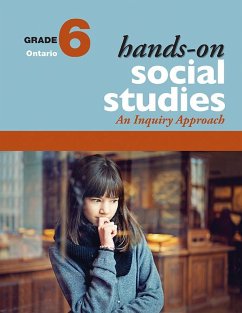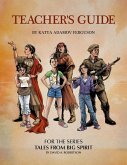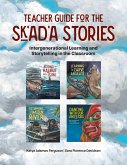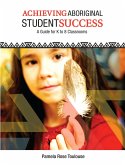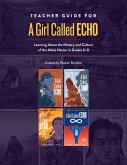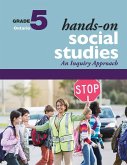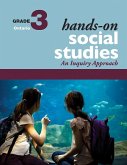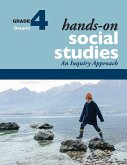67,95 €
67,95 €
inkl. MwSt.
Sofort per Download lieferbar

34 °P sammeln
67,95 €
Als Download kaufen

67,95 €
inkl. MwSt.
Sofort per Download lieferbar

34 °P sammeln
Jetzt verschenken
Alle Infos zum eBook verschenken
67,95 €
inkl. MwSt.
Sofort per Download lieferbar
Alle Infos zum eBook verschenken

34 °P sammeln
- Format: PDF
- Merkliste
- Auf die Merkliste
- Bewerten Bewerten
- Teilen
- Produkt teilen
- Produkterinnerung
- Produkterinnerung

Bitte loggen Sie sich zunächst in Ihr Kundenkonto ein oder registrieren Sie sich bei
bücher.de, um das eBook-Abo tolino select nutzen zu können.
Hier können Sie sich einloggen
Hier können Sie sich einloggen
Sie sind bereits eingeloggt. Klicken Sie auf 2. tolino select Abo, um fortzufahren.

Bitte loggen Sie sich zunächst in Ihr Kundenkonto ein oder registrieren Sie sich bei bücher.de, um das eBook-Abo tolino select nutzen zu können.
Filled with a year's worth of classroom-tested activities, this resource conveniently includes everything both teachers and students need.
The grade 6 book is divided into two units:
Communities in Canada, Past and Present | Canada's Interactions with the Global Community
STAND-OUT FEATURES
focuses on the goals of the Ontario Social Studies curriculum | adheres to the Growing Success document for assessment, evaluating, and reporting in Ontario schools | builds understanding of Indigenous knowledge and perspectives
TIME-SAVING, COST-EFFECTIVE FEATURES
includes the…mehr
- Geräte: PC
- mit Kopierschutz
- eBook Hilfe
- Größe: 24.55MB
Andere Kunden interessierten sich auch für
![Teacher's Guide For The Series Tales From Big Spirit (eBook, PDF) Teacher's Guide For The Series Tales From Big Spirit (eBook, PDF)]() Katya Adamov FergusonTeacher's Guide For The Series Tales From Big Spirit (eBook, PDF)13,95 €
Katya Adamov FergusonTeacher's Guide For The Series Tales From Big Spirit (eBook, PDF)13,95 €![Teacher Guide for the Sk'ad'a Stories (eBook, PDF) Teacher Guide for the Sk'ad'a Stories (eBook, PDF)]() Katya Adamov FergusonTeacher Guide for the Sk'ad'a Stories (eBook, PDF)11,95 €
Katya Adamov FergusonTeacher Guide for the Sk'ad'a Stories (eBook, PDF)11,95 €![Achieving Aboriginal Student Success (eBook, PDF) Achieving Aboriginal Student Success (eBook, PDF)]() Pamela Rose ToulouseAchieving Aboriginal Student Success (eBook, PDF)13,95 €
Pamela Rose ToulouseAchieving Aboriginal Student Success (eBook, PDF)13,95 €![Teacher Guide for A Girl Called Echo (eBook, PDF) Teacher Guide for A Girl Called Echo (eBook, PDF)]() Reuben BouletteTeacher Guide for A Girl Called Echo (eBook, PDF)12,95 €
Reuben BouletteTeacher Guide for A Girl Called Echo (eBook, PDF)12,95 €![Hands-On Social Studies for Ontario, Grade 5 (eBook, PDF) Hands-On Social Studies for Ontario, Grade 5 (eBook, PDF)]() Jennifer E. LawsonHands-On Social Studies for Ontario, Grade 5 (eBook, PDF)67,95 €
Jennifer E. LawsonHands-On Social Studies for Ontario, Grade 5 (eBook, PDF)67,95 €![Hands-On Social Studies for Ontario, Grade 3 (eBook, PDF) Hands-On Social Studies for Ontario, Grade 3 (eBook, PDF)]() Jennifer E. LawsonHands-On Social Studies for Ontario, Grade 3 (eBook, PDF)67,95 €
Jennifer E. LawsonHands-On Social Studies for Ontario, Grade 3 (eBook, PDF)67,95 €![Hands-On Social Studies for Ontario, Grade 4 (eBook, PDF) Hands-On Social Studies for Ontario, Grade 4 (eBook, PDF)]() Jennifer E. LawsonHands-On Social Studies for Ontario, Grade 4 (eBook, PDF)67,95 €
Jennifer E. LawsonHands-On Social Studies for Ontario, Grade 4 (eBook, PDF)67,95 €-
-
-
Filled with a year's worth of classroom-tested activities, this resource conveniently includes everything both teachers and students need.
The grade 6 book is divided into two units:
STAND-OUT FEATURES
TIME-SAVING, COST-EFFECTIVE FEATURES
The grade 6 book is divided into two units:
- Communities in Canada, Past and Present
- Canada's Interactions with the Global Community
STAND-OUT FEATURES
- focuses on the goals of the Ontario Social Studies curriculum
- adheres to the Growing Success document for assessment, evaluating, and reporting in Ontario schools
- builds understanding of Indigenous knowledge and perspectives
TIME-SAVING, COST-EFFECTIVE FEATURES
- includes the five components of the inquiry model
- opportunities for self-reflection and activating prior knowledge
- authentic assessment for, as, and of learning
- social studies thinking concepts, guided inquiry questions, and learning goals
- support for developing historical thinking skills
- access to digital image banks and digital reproducibles (Find download instructions in the Appendix of the book)
Dieser Download kann aus rechtlichen Gründen nur mit Rechnungsadresse in A, D ausgeliefert werden.
Produktdetails
- Produktdetails
- Verlag: Portage & Main Press
- Seitenzahl: 228
- Erscheinungstermin: 30. Juni 2021
- Englisch
- ISBN-13: 9781553799559
- Artikelnr.: 69987472
- Verlag: Portage & Main Press
- Seitenzahl: 228
- Erscheinungstermin: 30. Juni 2021
- Englisch
- ISBN-13: 9781553799559
- Artikelnr.: 69987472
- Herstellerkennzeichnung Die Herstellerinformationen sind derzeit nicht verfügbar.
Jennifer E. Lawson, PhD, is the creator of the Hands-On books published by Portage & Main Press. As senior writer and editor for the series, she has contributed to more than 50 publications for teachers and students. Jennifer provides professional development workshops for educators locally, nationally, and virtually, and is a Workplace Wellness Advisor. Her most recent book is a collective effort called Teacher, Take Care: A Guide to Well-Being and Workplace Wellness for Educators. She is also one of the founders of Mission to Mexico, an organization that supports schools in some of the most impoverished communities in Puerto Vallarta. Throughout her extensive career in education, Jennifer has worked as a classroom teacher, resource and special education teacher, consultant, principal, university instructor, and school trustee. She lives with her family in Winnipeg, Manitoba.
Introduction to Hands-On Social Studies, Grade 6 1
1. Program Introduction 2
2. What Is Social Studies? 2
3. The Goals of Social Studies 2
4. The Inquiry Approach to Social Studies 2
5. Hands-On Social Studies Curriculum Expectations 3
* Overall Expectations 3
* Concepts of Disciplinary Thinking 3
* Big Ideas 3
* Specific Expectations 4
6. Hands-On Social Studies Program Principles 4
7. Cultural Connections 4
8. Indigenous Knowledge, Experience, and Perspectives 4
9. Program Implementation 7
* Program Resources 7
* Lessons 8
10. Accommodating Diverse Learners 9
11. Classroom Environment 9
12. Planning Units (Timelines) 10
13. Classroom Management 10
14. Social Studies Skills: Guidelines for Teachers 10
* Communication 10
* Vocabulary 14
* Geographic Definition 14
* Research 15
The Hands-On Social Studies Assessment Plan 16
* Assessment for Learning 17
* Assessment as Learning 17
* Assessment of Learning 17
* Performance Assessment 18
* Portfolios 18
* Summative Achievement Levels 19
* Indigenous Perspectives on Assessment 19
* Important Note to Teachers 19
* References 20
* Social Studies Achievement Chart 21
* Assessment Templates 23
Heritage and Identity: Communities in Canada, Past and Present 35
15. About This Unit 36
16. Unit Overview 38
17. Curricular Expectations 39
18. Social Studies Thinking Concepts: Success Criteria 41
19. Cross-Curricular Connections 42
20. Resources for Students 43
* 1 Launching the Unit: Significant Canadians 47
* 2 Canada's Demographic Growth 52
* 3 Early Indigenous Peoples 58
* 4 Contributions of Indigenous Peoples 64
* 5 Immigrating to Canada 68
* 6 The French and English Settlers 77
* 7 Relationships Between Indigenous Peoples and Europeans 84
* 8 Treaties 88
* 9 Human Rights in Canada 93
* 10 Our Community: Past and Present 99
* 11 Canadian Identities 105
* 12 Communities in Canada Heritage Fair 112
* 13 Comparing Communities in Canada 118
21. References for Teachers 122
People and Environments: Canada's Interactions With the Global Community
125
22. About This Unit 126
23. Unit Overview 129
24. Curricular Expectations 130
25. Social Studies Thinking Concepts: Success Criteria 132
26. Cross-Curricular Connections 133
27. Resources for Students 134
* 1 Launching the Unit: Interacting With the World 138
* 2 Economic Interrelationships 143
* 3 Canada's Economic Relationships: Imports 149
* 4 Canada's Economic Relationships: Exports 155
* 5 Environmental Impact 160
* 6 Tourism 165
* 7 Longitude and Latitude 169
* 8 Canada and the United States 173
* 9 Comparing Countries 178
* 10 If the World Were a Village 182
* 11 Global Issues 186
* 12 Canada's International Role 190
* 13 Canadian Involvement in NGOs, IGOs, and GOs 196
* 14 Culminating Project: Global Issues Inquiry 201
28. References for Teachers 206
Appendix: Image Banks 207
About the Contributors 223
1. Program Introduction 2
2. What Is Social Studies? 2
3. The Goals of Social Studies 2
4. The Inquiry Approach to Social Studies 2
5. Hands-On Social Studies Curriculum Expectations 3
* Overall Expectations 3
* Concepts of Disciplinary Thinking 3
* Big Ideas 3
* Specific Expectations 4
6. Hands-On Social Studies Program Principles 4
7. Cultural Connections 4
8. Indigenous Knowledge, Experience, and Perspectives 4
9. Program Implementation 7
* Program Resources 7
* Lessons 8
10. Accommodating Diverse Learners 9
11. Classroom Environment 9
12. Planning Units (Timelines) 10
13. Classroom Management 10
14. Social Studies Skills: Guidelines for Teachers 10
* Communication 10
* Vocabulary 14
* Geographic Definition 14
* Research 15
The Hands-On Social Studies Assessment Plan 16
* Assessment for Learning 17
* Assessment as Learning 17
* Assessment of Learning 17
* Performance Assessment 18
* Portfolios 18
* Summative Achievement Levels 19
* Indigenous Perspectives on Assessment 19
* Important Note to Teachers 19
* References 20
* Social Studies Achievement Chart 21
* Assessment Templates 23
Heritage and Identity: Communities in Canada, Past and Present 35
15. About This Unit 36
16. Unit Overview 38
17. Curricular Expectations 39
18. Social Studies Thinking Concepts: Success Criteria 41
19. Cross-Curricular Connections 42
20. Resources for Students 43
* 1 Launching the Unit: Significant Canadians 47
* 2 Canada's Demographic Growth 52
* 3 Early Indigenous Peoples 58
* 4 Contributions of Indigenous Peoples 64
* 5 Immigrating to Canada 68
* 6 The French and English Settlers 77
* 7 Relationships Between Indigenous Peoples and Europeans 84
* 8 Treaties 88
* 9 Human Rights in Canada 93
* 10 Our Community: Past and Present 99
* 11 Canadian Identities 105
* 12 Communities in Canada Heritage Fair 112
* 13 Comparing Communities in Canada 118
21. References for Teachers 122
People and Environments: Canada's Interactions With the Global Community
125
22. About This Unit 126
23. Unit Overview 129
24. Curricular Expectations 130
25. Social Studies Thinking Concepts: Success Criteria 132
26. Cross-Curricular Connections 133
27. Resources for Students 134
* 1 Launching the Unit: Interacting With the World 138
* 2 Economic Interrelationships 143
* 3 Canada's Economic Relationships: Imports 149
* 4 Canada's Economic Relationships: Exports 155
* 5 Environmental Impact 160
* 6 Tourism 165
* 7 Longitude and Latitude 169
* 8 Canada and the United States 173
* 9 Comparing Countries 178
* 10 If the World Were a Village 182
* 11 Global Issues 186
* 12 Canada's International Role 190
* 13 Canadian Involvement in NGOs, IGOs, and GOs 196
* 14 Culminating Project: Global Issues Inquiry 201
28. References for Teachers 206
Appendix: Image Banks 207
About the Contributors 223
Introduction to Hands-On Social Studies, Grade 6 1
1. Program Introduction 2
2. What Is Social Studies? 2
3. The Goals of Social Studies 2
4. The Inquiry Approach to Social Studies 2
5. Hands-On Social Studies Curriculum Expectations 3
* Overall Expectations 3
* Concepts of Disciplinary Thinking 3
* Big Ideas 3
* Specific Expectations 4
6. Hands-On Social Studies Program Principles 4
7. Cultural Connections 4
8. Indigenous Knowledge, Experience, and Perspectives 4
9. Program Implementation 7
* Program Resources 7
* Lessons 8
10. Accommodating Diverse Learners 9
11. Classroom Environment 9
12. Planning Units (Timelines) 10
13. Classroom Management 10
14. Social Studies Skills: Guidelines for Teachers 10
* Communication 10
* Vocabulary 14
* Geographic Definition 14
* Research 15
The Hands-On Social Studies Assessment Plan 16
* Assessment for Learning 17
* Assessment as Learning 17
* Assessment of Learning 17
* Performance Assessment 18
* Portfolios 18
* Summative Achievement Levels 19
* Indigenous Perspectives on Assessment 19
* Important Note to Teachers 19
* References 20
* Social Studies Achievement Chart 21
* Assessment Templates 23
Heritage and Identity: Communities in Canada, Past and Present 35
15. About This Unit 36
16. Unit Overview 38
17. Curricular Expectations 39
18. Social Studies Thinking Concepts: Success Criteria 41
19. Cross-Curricular Connections 42
20. Resources for Students 43
* 1 Launching the Unit: Significant Canadians 47
* 2 Canada's Demographic Growth 52
* 3 Early Indigenous Peoples 58
* 4 Contributions of Indigenous Peoples 64
* 5 Immigrating to Canada 68
* 6 The French and English Settlers 77
* 7 Relationships Between Indigenous Peoples and Europeans 84
* 8 Treaties 88
* 9 Human Rights in Canada 93
* 10 Our Community: Past and Present 99
* 11 Canadian Identities 105
* 12 Communities in Canada Heritage Fair 112
* 13 Comparing Communities in Canada 118
21. References for Teachers 122
People and Environments: Canada's Interactions With the Global Community
125
22. About This Unit 126
23. Unit Overview 129
24. Curricular Expectations 130
25. Social Studies Thinking Concepts: Success Criteria 132
26. Cross-Curricular Connections 133
27. Resources for Students 134
* 1 Launching the Unit: Interacting With the World 138
* 2 Economic Interrelationships 143
* 3 Canada's Economic Relationships: Imports 149
* 4 Canada's Economic Relationships: Exports 155
* 5 Environmental Impact 160
* 6 Tourism 165
* 7 Longitude and Latitude 169
* 8 Canada and the United States 173
* 9 Comparing Countries 178
* 10 If the World Were a Village 182
* 11 Global Issues 186
* 12 Canada's International Role 190
* 13 Canadian Involvement in NGOs, IGOs, and GOs 196
* 14 Culminating Project: Global Issues Inquiry 201
28. References for Teachers 206
Appendix: Image Banks 207
About the Contributors 223
1. Program Introduction 2
2. What Is Social Studies? 2
3. The Goals of Social Studies 2
4. The Inquiry Approach to Social Studies 2
5. Hands-On Social Studies Curriculum Expectations 3
* Overall Expectations 3
* Concepts of Disciplinary Thinking 3
* Big Ideas 3
* Specific Expectations 4
6. Hands-On Social Studies Program Principles 4
7. Cultural Connections 4
8. Indigenous Knowledge, Experience, and Perspectives 4
9. Program Implementation 7
* Program Resources 7
* Lessons 8
10. Accommodating Diverse Learners 9
11. Classroom Environment 9
12. Planning Units (Timelines) 10
13. Classroom Management 10
14. Social Studies Skills: Guidelines for Teachers 10
* Communication 10
* Vocabulary 14
* Geographic Definition 14
* Research 15
The Hands-On Social Studies Assessment Plan 16
* Assessment for Learning 17
* Assessment as Learning 17
* Assessment of Learning 17
* Performance Assessment 18
* Portfolios 18
* Summative Achievement Levels 19
* Indigenous Perspectives on Assessment 19
* Important Note to Teachers 19
* References 20
* Social Studies Achievement Chart 21
* Assessment Templates 23
Heritage and Identity: Communities in Canada, Past and Present 35
15. About This Unit 36
16. Unit Overview 38
17. Curricular Expectations 39
18. Social Studies Thinking Concepts: Success Criteria 41
19. Cross-Curricular Connections 42
20. Resources for Students 43
* 1 Launching the Unit: Significant Canadians 47
* 2 Canada's Demographic Growth 52
* 3 Early Indigenous Peoples 58
* 4 Contributions of Indigenous Peoples 64
* 5 Immigrating to Canada 68
* 6 The French and English Settlers 77
* 7 Relationships Between Indigenous Peoples and Europeans 84
* 8 Treaties 88
* 9 Human Rights in Canada 93
* 10 Our Community: Past and Present 99
* 11 Canadian Identities 105
* 12 Communities in Canada Heritage Fair 112
* 13 Comparing Communities in Canada 118
21. References for Teachers 122
People and Environments: Canada's Interactions With the Global Community
125
22. About This Unit 126
23. Unit Overview 129
24. Curricular Expectations 130
25. Social Studies Thinking Concepts: Success Criteria 132
26. Cross-Curricular Connections 133
27. Resources for Students 134
* 1 Launching the Unit: Interacting With the World 138
* 2 Economic Interrelationships 143
* 3 Canada's Economic Relationships: Imports 149
* 4 Canada's Economic Relationships: Exports 155
* 5 Environmental Impact 160
* 6 Tourism 165
* 7 Longitude and Latitude 169
* 8 Canada and the United States 173
* 9 Comparing Countries 178
* 10 If the World Were a Village 182
* 11 Global Issues 186
* 12 Canada's International Role 190
* 13 Canadian Involvement in NGOs, IGOs, and GOs 196
* 14 Culminating Project: Global Issues Inquiry 201
28. References for Teachers 206
Appendix: Image Banks 207
About the Contributors 223
